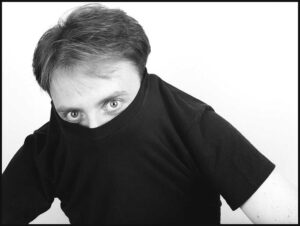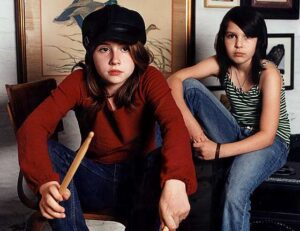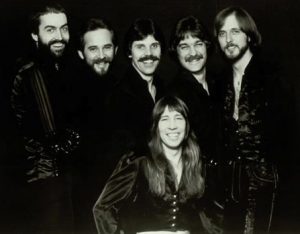 I know absolutely nothing about the band Cat Fight — I couldn’t even find a photo of them, so that’s a photo of my cat. There’s a reason why I have a copy of their song “Do the Pussycat,” though, and why it brought a smile to my face when it came up on iTunes shuffle.
I know absolutely nothing about the band Cat Fight — I couldn’t even find a photo of them, so that’s a photo of my cat. There’s a reason why I have a copy of their song “Do the Pussycat,” though, and why it brought a smile to my face when it came up on iTunes shuffle.
Back in the early ’90s after I first discovered the Mekons, I went to see them play live as often as possible. And that was a lot of possible: Despite living mostly in England (and partly in Chicago and other places), they still found time to play New York–area venues like Maxwell’s or the Marquee or Irving Plaza every few months, and I made sure always to be there, front and center.
After a bunch of these shows, I started noticing that there were a few other people who kept showing up front and center as well, and worked up the nerve to introduce myself. One was a woman named Courtney with a purple streak in her hair — I almost wrote “a woman with a purple streak in her hair named Courtney,” which would be a totally different thing — who I still go to shows with today, and who you may remember from her appearance in the Superchunk item. Two others were a couple about my age, he wry and friendly and she enthusiastic and quick-witted (and vice versa); most nights she wore a shirt with “Mekons” embroidered in script over the chest pocket. They were Hova and Belinda, and it is no exaggeration to say that this meeting changed my life.
Hova and Belinda, it eventually transpired, had just started hosting a Saturday morning radio show on a radio station called WFMU, which was off in northern New Jersey somewhere, but you could just about tune it in from New York City with some perseverance and a good enough antenna. (One article in the WFMU magazine, I recall, recommended taking a wire antenna, balling it up in your hand, and throwing it onto a coffee table to see if it landed in a way that would provide good reception. I eventually tried this method; it didn’t work too badly, or at least not any worse than any other methods.) At the time, I’d vaguely heard of WFMU, from my friend Stacey who knew about strange countercultural artsy things, but had never actually listened to the station. After meeting real live WFMU DJs, though, I tuned my stereo to 91.1 FM and checked out my first “Greasy Kid Stuff.”
I would usually describe GKS to friends and other potential converts as “a kids’ music show for grownups,” but it was more than that — and more even than a grownups’ music show for kids, which it also was at times. Mostly, it was a weekly two-hour celebration of music for all ages, with a particular twisted humor that was all its own. It’s where I was first introduced to James Kochalka Superstar’s “Monkey vs. Robot,” and Logan Whitehurst’s “Lizard and Fish,” and the epic birthday song “Gimme” by the epic New Zealanders Fatcat & Fishface, and the bit of beautiful inspired lunacy that is Gloria Balsam’s “Fluffy.” There were regular visits from Uncle Randy’s Story Minute with its tales of the sad-sack protagonist Lance and his run-ins with vanishing pants and ducks that practiced mind control; each show ended with a sound clip declaring, “Now beat it, you little mountebanks, back to Whimsy Town with you!” Greasy Kid Stuff was a better place, where mad geniuses were patron saints, and we all joined together each week to celebrate anyone who was having a birthday, or anyone who’s ever had a birthday, or anyone who was thinking about having a birthday. I still have to remind myself sometimes that it really existed.
But then, as I soon discovered, much the same went for WFMU as a whole. If we left the radio on after being dispatched back to Whimsy Town, we would get to visit Laura Cantrell’s Radio Thrift Shop, which dug through dusty shelves of pre-Nashville country to find old-time magic. A couple of years later, the slot after Radio Thrift Shop was filled by Terre T’s Cherry Blossom Clinic, where I was introduced to a world of garage and punk rock that existed in a place far afield even from the likes of the Mekons. And then there was the whole rest of the week, and the annual fundraising marathons that put NPR’s tote-bag peddling to shame (one year I won a G.G. Allin bobblehead), all dedicated to the oft-stated premise that no matter what kind of music you preferred, there was always a good chance that you could turn on WFMU any time of the week and hear something you absolutely hated.
Six months after our son was born, Hova and Belinda had a daughter named Georgia, who was quickly incorporated into the on-air lineup (first as DJ Waah Waah, eventually under her own name); a couple of years after that, they moved to Portland, Oregon. The show eventually followed them, first to a commercial rock station that trimmed it to an unconscionable half-hour, and eventually to XRAY.FM, a clearly WFMU-inspired freeform station, which launched in 2014 with an hour-long GKS back on Saturday mornings, still staying crunchy in your milk.
Hova and Belinda finally ended Greasy Kid Stuff for good in June 2017 after 23 years, choosing to retire from the show while they were still young enough to enjoy their now-free weekends. WFMU, of course, is still around and going strong (or as strong as an entirely listener-supported radio station with a million-dollar-plus budget to meet every year can ever be); I’m listening to Michael Shelley’s latest show (via archive streaming) as I type this, and I tune in regularly to Todd-o-phonic Todd and Joe Belock as well, and irregularly at other times when I need a bit of random weirdness in my life. (There is, or was, a death metal show that I absolutely can’t stand, but it’s also the only place I’ve ever heard Hatebeak, so I have to check in every once in a while.) And XRAY is still around as well, and I’m always pleasantly surprised when I tune in, which is not something I’ve been able to say about any other radio stations — or Spotify or what have you — in, oh, decades.
Greasy Kid Stuff also still lives on, not just in its archived shows on WFMU and XRAY, but also in three professionally released CD compilations (one of which was playing in the delivery room when our son was born), plus a dozen or so CD mixtapes issued as premiums for pledgers to WFMU’s fund drive. “Do the Pussycat” features on the 2005 edition, a set of dog-and-cat-themed songs appropriately titled “DJ Waah Waah Stepped in a Poodle.” I may never find out what strange corner of the universe this song emerged from, but I give thanks to Hova, Belinda, Georgia, WFMU, the Mekons, and the front section of Maxwell’s for helping lead me to it.









